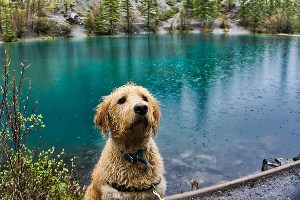
There is no doubt that dogs are man’s best friend.
But, what do you do if your dog’s water bowl is not clean and it looks like algae have grown in the water? What could happen if your dog drinks that water?
This article will explore the topic of algae in dog water bowls.
What is Algae?
Algae is a green, brown, and red plant-like substance that will grow in both fresh and saltwater. There are over 16,000 types of algae that you can find in the world. It is usually found in or near water and is essential to some aquatic plants.
When algae start growing in your dog’s water bowl, it means that you are not regularly cleaning it. And it can result in an infection in your dog’s gut.
Why is that?
Well, an unclean water bowl is a perfect environment for other germs to thrive. A dirty water bowl can harbor germs such as E.coli, salmonella, and MRSA.
So, it is crucial to keep your dog’s water bowl clean.
Why is water so important for dogs?
Water is essential for your dog to function correctly.
They need water to stay hydrated and function properly. Not only that, but water also plays a vital role in your dog’s health. Water also helps to keep your dog cool in the summer heat. It helps to regulate your dog’s body temperature.
Here are some of the health benefits of water for your dog:
1. Aids in digestion – Canines are made up of 70 – 80% water, just like humans. So, your dog’s fluid levels are significant to keep your dog hydrated. Water also helps to break down food in your dog’s digestive system.
2. Hydrates your dog’s body – Water keeps your dog’s body temperature regulated. Water helps to lower your dog’s body temperature in the summer heat. So, make sure that your dog’s water bowl is kept clean and fresh at all times.
3. Flushes out toxins and wastes – Proper water intake helps flush out the toxins in your dog’s body. A dog that drinks a lot of water is usually clean. Proper hydration also helps to keep your dog from getting sick.
4. Helps to keep your dog focused and alert – Water is essential for your dog’s brain function. A dog that has a water deficit can get severely stressed. So make sure that you supply your dog with a clean and fresh water bowl every day.
What are the algae in a dog’s water bowl?
The algae in your dog’s water bowl is a rapidly growing plant-like substance.
The growth rate depends on many factors.
It includes the amount of sunlight, nutrients available, and how much oxygen there is in the air.
If these conditions are right, then the algae will begin to multiply quickly.
The more time that passes without proper care, the faster this process happens.
The type of algae that your dog’s water bowl produces is called green algae. Here are the different types of green algae that you can find in your dog’s water bowl:
1. Green water algae – The green algae that grow in your dog’s water bowl are widespread. It has a whitish shade to it, giving it the appearance of green slime. The green slime usually appears on the water’s surface or at the bottom of your dog’s water bowl. Green algae are typically harmless for your dog. But it can cause irritation, itching, and redness if your dog ingests it.
2. Blue-green algae – Blue-green algae can be toxic to both humans and animals. It has the same appearance as the standard green algae but is more harmful to dogs than green algae is. If your dog consumes blue-green algae, it may experience vomiting, diarrhea, and incoordination. Blue-green algae can be found in ponds or lakes.
How does it appear?
The appearance of green algae in your dog’s water bowl depends on how old the water is.
If the water in the bowl is new.
The green algae are not likely to appear.
If, however, the water has been sitting in the bowl for a while.
The green algae will start growing.
The blue-green algae tend to form when the water gets warm.
It means that warmer temperatures promote the growth of these organisms.
You should always check your dog’s water bowl daily to ensure that it contains no signs of contamination.
What parasites or bacteria might your dogs catch?
Many kinds of microorganisms will live in your dog’s water bowl.
Some of them include protozoa, viruses, bacteria, fungi, and other microscopic life forms. These organisms are tiny and cannot be seen by the naked eye. They only need one cell to reproduce themselves. It makes them extremely dangerous because they multiply rapidly.
Some of the most common diseases caused by these organisms are:
- Giardia – This disease causes diarrhea and vomiting
- E.coli – This disease causes diarrhea and vomiting
- Salmonella – This disease causes diarrhea, vomiting, and sickness
- Campylobacter – This bacteria can cause severe diarrhea and vomiting
- Pseudomonas – This bacteria may cause pneumonia
- MRSA – This disease occurs when Staphylococcus aureus attacks your dog’s healthy tissues
Remember that even though your dog seems fine now.
It could still have an infection from consuming contaminated water.
You must take immediate action if this happens. Call your vet immediately so that they can treat your pet properly.
What is the best way of cleaning a dog’s water bowl?
To clean your dog’s water bowl.
First, make sure that all foreign objects such as toys, bones, etc., are removed before washing. Then, wash the outside with soap and hot water.
Rinse well after each use. It is also important to thoroughly clean the bowl’s interior. You can do this using either dishwashing liquid or baking soda. After rinsing, dry thoroughly.
Can a water bowl be cleaned with a natural product? (without using bleach, or dish soap, or detergent)
Yes! There are natural products available at home instead of harmful chemicals.
Some examples are vinegar, lemon juice, and baking soda.
All of these work great at removing stains and odors without harming your pet’s health. The best part about using natural products is that they are not harmful to your dog.
So there is no reason why you should not use them on your dog’s water bowl. How often should I change my dog’s water bowl?
Another advantage of using a natural product is that they have many positive effects on your dog’s health and well-being.
How often should a water bowl be cleaned?
It would be best if you cleaned your dog’s water bowl at least every day. Why? Well, that is mainly because dogs like to eat the dirt around their water bowl. If you do not clean your dog’s bowl regularly, they will ingest all bacteria and germs found in the water. Also, make sure that you check your dog’s water bowl at least twice a day.
What is the best way of keeping a dog’s drinking water clean?
Don’t wait for algae to grow, or the water becomes smelly. Do not wait for your dog to drink from it. You must always ensure that you remove all of the water from the bowl before giving more water to your dog. If you notice that your dog has been drinking dirty water, then you should replace their water right away. You must keep track of how much water your dog drinks daily.
It helps you know whether your dog needs more water or less. Remember that too little water intake leads to dehydration, leading to severe problems, including kidney failure.
Also, remember that some breeds of dogs require more frequent water changes than others.
What is the best material for a dog’s water bowl to be made from, and why?
One of the most common materials for a dog’s water bowl is stainless steel.
Its advantages include:
1. Does not rust
2. Does not break easily
3. Is hygienic and easy to clean
4. Is non-toxic and pet safe
A water bowl made from stainless steel can withstand any weather condition, whether hot or cold. The only tricky thing with this material is that it is prone to scratches if your dog’s nails are long and sharp.
What are the advantages of stainless steel?
The stainless steel water bowl is one of the most hygienic and non-toxic options for dog’s water bowls. You can easily clean stainless steel with a mixture of vinegar and baking soda. Do not forget to rinse it well before placing it back in your dog’s room.
What are the disadvantages of stainless steel?
One disadvantage of this material is that it is prone to scratches. Suppose your dog’s nails are long and sharp. Stainless steel can also be scratched by a rock or any other hard object. Another disadvantage of stainless steel is that it does not absorb heat or cold. If you keep the stainless steel bowl outside, it does not help to keep water cool on a hot summer day.
Filtered vs. tap water vs. spring water- which is better for your dog?
The type of water used depends upon where you live. Some areas have high levels of chlorine, while others don’t. In addition, some places add fluoride to their drinking water. Below are some advantages and disadvantages of filtered, tap, and spring water.
Advantages of filtered water
Suppose you live in an area where chlorine is added to the water supply. You can buy a filter at your local store. It will allow your dog to safely drink from the water bowl without being exposed to high levels of chlorine.
Disadvantages of filtered water
Filtered water can be expensive. A jug of filtered water costs more than a jug of straight tap water. This is because the filtering system has to be maintained, and it needs to be replaced frequently.
Advantages of tap water
Tap water is the cheapest option available. If your dog lives in an area with low to no chlorines added, then tap water is perfect for your dog. Just be aware that the water coming out of the hose may taste different than what you are used to drinking.
Disadvantages of tap water
There is no way to remove the minerals and chemicals added to tap water before it is delivered to your home. So, these minerals and chemicals can be harmful to your pet. Also, there is no way to filter out the chlorine from tap water.
Advantages of spring water
If you live in an area where tap water is not available, or the quality of the tap water is questionable, you can purchase spring water. Springwater is usually free from all forms of chemicals and minerals, and it has a consistent quality every time. If you live in an area with poor or no tap water, then this might be the best option for your pet.
Disadvantages of spring water
Spring-water can be expensive. A jug of spring water costs more than a jug of straight tap water. It is because the filtering system has to be maintained, and it needs to be replaced frequently.
Closing Thoughts:
Your dog’s water bowl is an integral part of your dog’s health and safety. Keeping their water clean is one of the most important things you can do for your pet. Remember, bacteria and germs can quickly grow in a water bowl. If you follow the steps listed above, you will be able to keep your dog’s water clean and fresh.
It is also essential to keep your dog’s water bowl away from direct sunlight. Keep in mind that algae spreads faster in direct sunlight. Lastly, be sure to check your dog’s water bowl every day to ensure that it does not have a foul or strange odor. Your dog’s health is dependent upon it.






